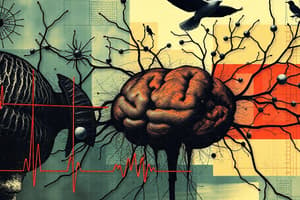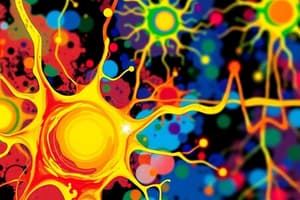Podcast
Questions and Answers
What is the primary function of myelin in the context of a neuron?
What is the primary function of myelin in the context of a neuron?
- Releasing transmitter molecules
- Insulating the nerve cell and speeding up the conduction of nerve messages (correct)
- Creating transmitter molecules
- Receiving information from other neurons
Which of the following best describes the role of dendrites in a neuron?
Which of the following best describes the role of dendrites in a neuron?
- To transmit signals to other neurons
- To receive information from other neurons (correct)
- To insulate the axon and speed up signal transmission
- To release neurotransmitters into the synapse
What is the effect of potassium ions (K+) flowing out of a neuron's membrane?
What is the effect of potassium ions (K+) flowing out of a neuron's membrane?
- Hyperpolarization of the membrane (correct)
- Repolarization of the membrane
- Depolarization of the membrane
- Stabilization of the membrane potential
During an action potential, what causes the membrane potential to reach approximately +40mV?
During an action potential, what causes the membrane potential to reach approximately +40mV?
What process restores the neuron's membrane potential to its resting state of approximately -70mV after depolarization?
What process restores the neuron's membrane potential to its resting state of approximately -70mV after depolarization?
What happens to neurotransmitters after they have been released into the synapse and have bound to receptors?
What happens to neurotransmitters after they have been released into the synapse and have bound to receptors?
Which neurotransmitter is most directly associated with motor movement and is implicated in Alzheimer's disease when its function is disrupted?
Which neurotransmitter is most directly associated with motor movement and is implicated in Alzheimer's disease when its function is disrupted?
What is the primary role of the neurotransmitter GABA (gamma-aminobutyric acid) in the nervous system?
What is the primary role of the neurotransmitter GABA (gamma-aminobutyric acid) in the nervous system?
Which neurotransmitter is primarily associated with the regulation of emotional states and is often linked to feelings of well-being and control?
Which neurotransmitter is primarily associated with the regulation of emotional states and is often linked to feelings of well-being and control?
Excessive activity of which neurotransmitter is most closely associated with schizophrenia?
Excessive activity of which neurotransmitter is most closely associated with schizophrenia?
What is the main function of the sympathetic nervous system?
What is the main function of the sympathetic nervous system?
Which area of the brain is primarily involved in the control of heart rate and respiration?
Which area of the brain is primarily involved in the control of heart rate and respiration?
What is the primary function of the cerebellum?
What is the primary function of the cerebellum?
Which brain structure is most closely associated with the formation of new memories?
Which brain structure is most closely associated with the formation of new memories?
What is the primary function of the corpus callosum?
What is the primary function of the corpus callosum?
Which of the following functions is primarily associated with the frontal lobes?
Which of the following functions is primarily associated with the frontal lobes?
Which of the following is a primary function of the right hemisphere in most individuals?
Which of the following is a primary function of the right hemisphere in most individuals?
What is the main function of the endocrine system?
What is the main function of the endocrine system?
What is the effect of cutting the corpus callosum?
What is the effect of cutting the corpus callosum?
Which glands are responsible for the 'fight or flight' response by releasing hormones?
Which glands are responsible for the 'fight or flight' response by releasing hormones?
Flashcards
What are Dendrites?
What are Dendrites?
Receives information from other neurons, acting like an antenna.
What is the function of the Cell Body?
What is the function of the Cell Body?
Creates transmitter molecules; semipermeable.
What does Myelin do?
What does Myelin do?
Insulates the nerve cell and speeds up conduction of nerve messages.
What is the role of Terminal Buttons?
What is the role of Terminal Buttons?
Signup and view all the flashcards
What are Graded Potentials?
What are Graded Potentials?
Signup and view all the flashcards
What does Depolarization mean?
What does Depolarization mean?
Signup and view all the flashcards
What does Hyperpolarization mean?
What does Hyperpolarization mean?
Signup and view all the flashcards
What is the Action Potential (AP)?
What is the Action Potential (AP)?
Signup and view all the flashcards
What happens during Reuptake?
What happens during Reuptake?
Signup and view all the flashcards
What is the function of Acetylcholine (ACh)?
What is the function of Acetylcholine (ACh)?
Signup and view all the flashcards
What is Norepinephrine's role?
What is Norepinephrine's role?
Signup and view all the flashcards
What does Serotonin regulate?
What does Serotonin regulate?
Signup and view all the flashcards
What is the function of Dopamine?
What is the function of Dopamine?
Signup and view all the flashcards
What is the function of GABA?
What is the function of GABA?
Signup and view all the flashcards
What is the role of Glutamate?
What is the role of Glutamate?
Signup and view all the flashcards
What is the Sympathetic Nervous System?
What is the Sympathetic Nervous System?
Signup and view all the flashcards
What is the Parasympathetic Nervous System?
What is the Parasympathetic Nervous System?
Signup and view all the flashcards
What functions does the Medulla control?
What functions does the Medulla control?
Signup and view all the flashcards
What is the Cerebellum responsible for?
What is the Cerebellum responsible for?
Signup and view all the flashcards
What is the Hippocampus's function?
What is the Hippocampus's function?
Signup and view all the flashcards
Study Notes
- Neuroscience connects the brain with behavior
- Neuro is the study of the brain, which directs behaviors
Neuron Components
- Neurons are key parts of the nervous system
- Dendrites receive signals from other neurons, triggering a go/no-go response
- The cell body produces transmitter molecules and is semipermeable
- Axons are insulated by myelin, speeding up nerve message conduction
- Axon terminal buttons release transmitters
- Bundles of nerves consist of clustered axons
Graded Potentials
- Nerve membrane stimulation can open ion channels
- Influx of Na+ (sodium) depolarizes the membrane, shifting it from -70 mV to -60 mV
- Efflux of K+ (potassium) hyperpolarizes the membrane, shifting it from -70 mV to -90 mV
- Depolarization reduces polarization
- Hyperpolarization increases polarization
- The refractory period influences the rate of neuronal firing
Action Potential
- Graded potentials travel from dendrites to the axon hillock
- Action potentials (AP) occur if summed activity at the axon hillock exceeds the membrane potential threshold
- During an action potential, Na+ ions enter the cell, raising the membrane potential to +40mV and causing a spike
- K+ channel opening restores the membrane potential to -70mV
- Action potentials travel along the axon to the terminals
Post-Firing Events
- Post firing events include being pushed out (binded), or vacuumed up (reuptake)
- Enzymes deactivate neurotransmitters by taking them out as waste.
Major Neurotransmitters
- Acetylcholine (Ach) is responsible for motor movement, memory, sleep and dreaming
- Alzheimer's disease is related to acetylcholine disfunction
- Endogenous acetylcholine is manufactured inside the body
- Exogenous acetylcholine is manufactured outside the body, pretending to be a neurotransmitter
- Nicotine acts like acetylcholine
- Protagonist neurotransmitters mimic/enhance the effects of natural neurotransmitters
- Antagonist neurotransmitters block receptor sites, inhibiting neurotransmitter effects
- Epinephrine dilates blood vessels, and is part of the adrenaline package for fight or flight responses
- Norepinephrine regulates arousal, learning, and dreaming, and its levels relate to mania and depression
- Serotonin regulates emotional states and is important for self-control and basic life functions
- Dopamine is linked to reward and feeling good, and relates to anticipating desired things
- Too much dopamine can trigger schizophrenia
- Too little dopamine can trigger Parkinson's disease
- GABA (gamma-aminobutyric acid) is the most important neurotransmitter
- GABA is an amino acid
- Alcohol acts like GABA
- Low GABA levels correlate with anxiety
- Glutamate is an amino acid that enhances long-term potentiation, memory, and learning
- Too much glutamate can overstimulate neurons, causing headaches or seizures
Overview of the Nervous System
- Soma refers to body senses
Autonomic Nervous System (ANS)
- Contains sympathetic and parasympathetic divisions
- The sympathetic division is responsible for the emergency system and fight or flight response
- The parasympathetic division is responsible for vegetative functions such as digestion
- The two systems often oppose each other, such as in heart rate control
- The two systems can act in concert as in sexual reflexes
Midline Brain Structures
- The medulla controls heart rate and respiration
- The cerebellum coordinates smooth movements, balance, and posture
- The pons is involved in sleep regulation
Limbic System Functions
- The septal area drives pleasure and relief
- The amygdala contributes to learning and fear recognition; more sensitive amygdalae relate to anxiety
- The hippocampus is involved in memory
Cerebral Cortex Functions
- The cerebral cortex provides flexible movement control
- The cerebral cortex allows subtle sensory pattern discrimination
- The cerebral cortex enables symbolic thinking
- Symbolic thought is the base for language and human thought
Frontal Lobe and Personality
- Frontal lobes govern movement, attention, planning, memory, and personality
- The case of Phineas Gage reveals the frontal lobe's role in personality
- Gage suffered frontal lobe damage from a dynamite tamping rod accident
- Prior to the damage, Gage was a railroad supervisor
- Post-damage, Gage became childish, irreverent, impulsive, and struggled to plan
Cerebral Lateralization
- Cortex and sub-cortex structures show functional specialization
- Hemispheric Specialization describes how the left brain dominates language, logic, and complex motor actions
- The right brain dominates non-linguistic functions like recognizing faces, places, and sounds
- Hemispheric specializations are evident from brain-damage and split-brain studies
Split-Brain Studies
- Information from a visual field typically travels to the opposite visual cortex
- The corpus callosum integrates two hemispheres
- Cutting the corpus callosum can limit information to one hemisphere
- With a cut corpus callosum, language relies on information reaching the left hemisphere
The Endocrine System
- Glands secrete hormones into the bloodstream, regulating bodily functions
- The hypothalamus connects to the pituitary gland (master gland)
- Adrenal glands control fight-or-flight responses
- Gonads regulate secondary sex characteristics
Endocrine System Function
- Endocrine glands release hormones into the bloodstream
- Hormones exert effects across diffuse bodily sites
- Hormones bind to receptors
- Hormones exert organizational effects (permanent structure/function changes)
- Hormones exert activational effects
- Reduced testosterone diminishes sexual behavior
Studying That Suits You
Use AI to generate personalized quizzes and flashcards to suit your learning preferences.




